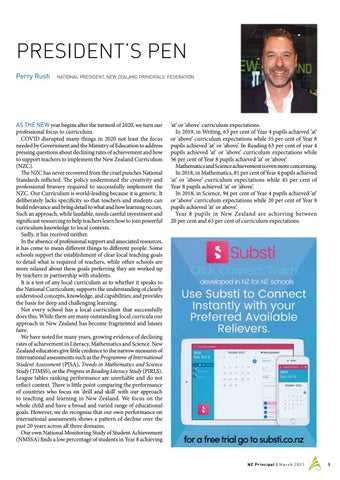President’s Pen Perry Rush
National President, New Zealand Principals’ Federation
As the new year begins after the turmoil of 2020, we turn our professional focus to curriculum. COVID disrupted many things in 2020 not least the focus needed by Government and the Ministry of Education to address pressing questions about declining rates of achievement and how to support teachers to implement the New Zealand Curriculum (NZC). The NZC has never recovered from the cruel punches National Standards inflicted. The policy undermined the creativity and professional bravery required to successfully implement the NZC. Our Curriculum is world-leading because it is generic. It deliberately lacks specificity so that teachers and students can build relevance and bring detail to what and how learning occurs. Such an approach, while laudable, needs careful investment and significant resourcing to help teachers learn how to join powerful curriculum knowledge to local contexts. Sadly, it has received neither. In the absence of professional support and associated resources, it has come to mean different things to different people. Some schools support the establishment of clear local teaching goals to detail what is required of teachers, while other schools are more relaxed about these goals preferring they are worked up by teachers in partnership with students. It is a test of any local curriculum as to whether it speaks to the National Curriculum; supports the understanding of clearly understood concepts, knowledge, and capabilities; and provides the basis for deep and challenging learning. Not every school has a local curriculum that successfully does this. While there are many outstanding local curricula our approach in New Zealand has become fragmented and laissez faire. We have noted for many years, growing evidence of declining rates of achievement in Literacy, Mathematics and Science. New Zealand educators give little credence to the narrow measures of international assessments such as the Programme of International Student Assessment (PISA), Trends in Mathematics and Science Study (TIMSS), or the Progress in Reading Literacy Study (PIRLS). League tables ranking performance are unreliable and do not reflect context. There is little point comparing the performance of countries who focus on ‘drill and skill’ with our approach to teaching and learning in New Zealand. We focus on the whole child and have a broad and varied range of educational goals. However, we do recognise that our own performance on international assessments shows a pattern of decline over the past 20 years across all three domains. Our own National Monitoring Study of Student Achievement (NMSSA) finds a low percentage of students in Year 8 achieving
‘at’ or ‘above’ curriculum expectations. In 2019, in Writing, 63 per cent of Year 4 pupils achieved ‘at’ or ‘above’ curriculum expectations while 35 per cent of Year 8 pupils achieved ‘at’ or ‘above’. In Reading 63 per cent of year 4 pupils achieved ‘at’ or ‘above’ curriculum expectations while 56 per cent of Year 8 pupils achieved ‘at’ or ‘above’. Mathematics and Science achievement is even more concerning. In 2018, in Mathematics, 81 per cent of Year 4 pupils achieved ‘at’ or ‘above’ curriculum expectations while 45 per cent of Year 8 pupils achieved ‘at’ or ‘above’. In 2018, in Science, 94 per cent of Year 4 pupils achieved ‘at’ or ‘above’ curriculum expectations while 20 per cent of Year 8 pupils achieved ‘at’ or above’. Year 8 pupils in New Zealand are achieving between 20 per cent and 63 per cent of curriculum expectations.
N Z Principal | M a r c h 2 0 2 1
5



